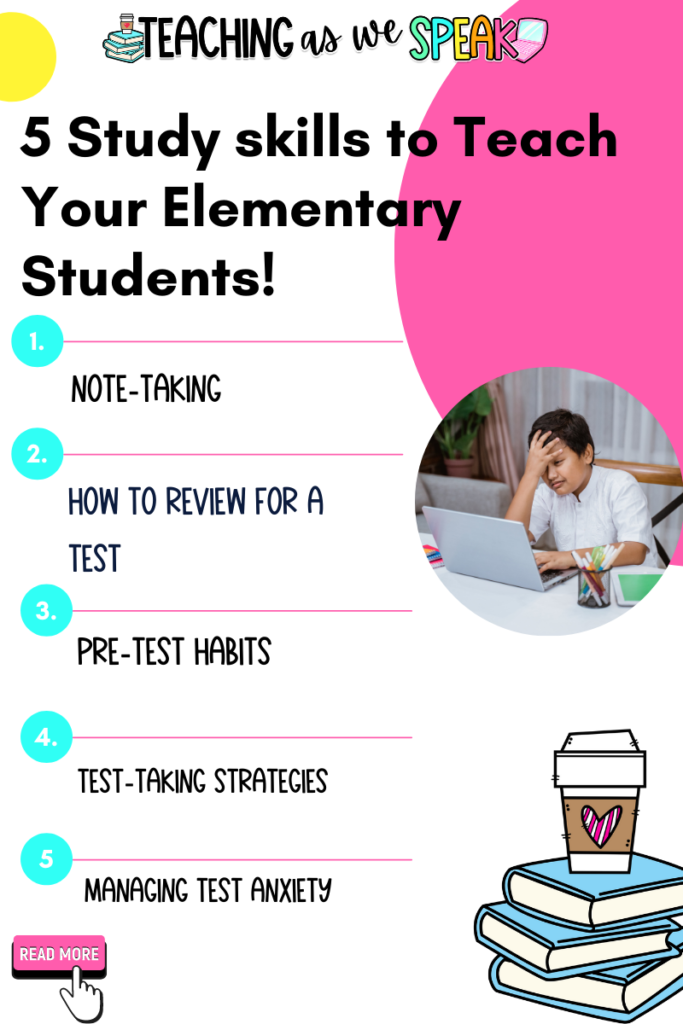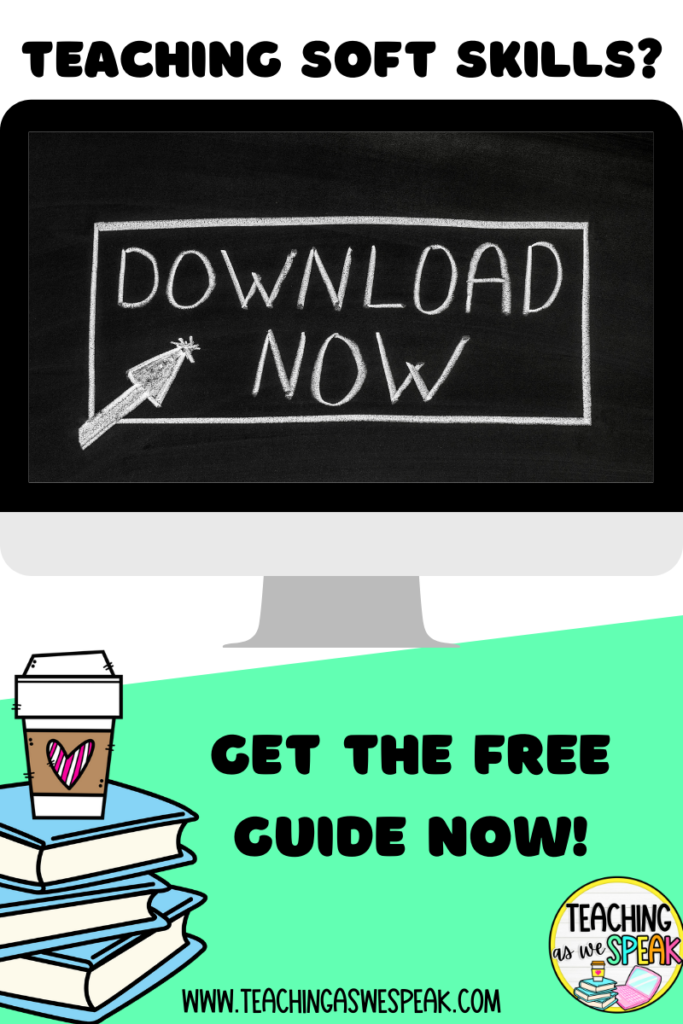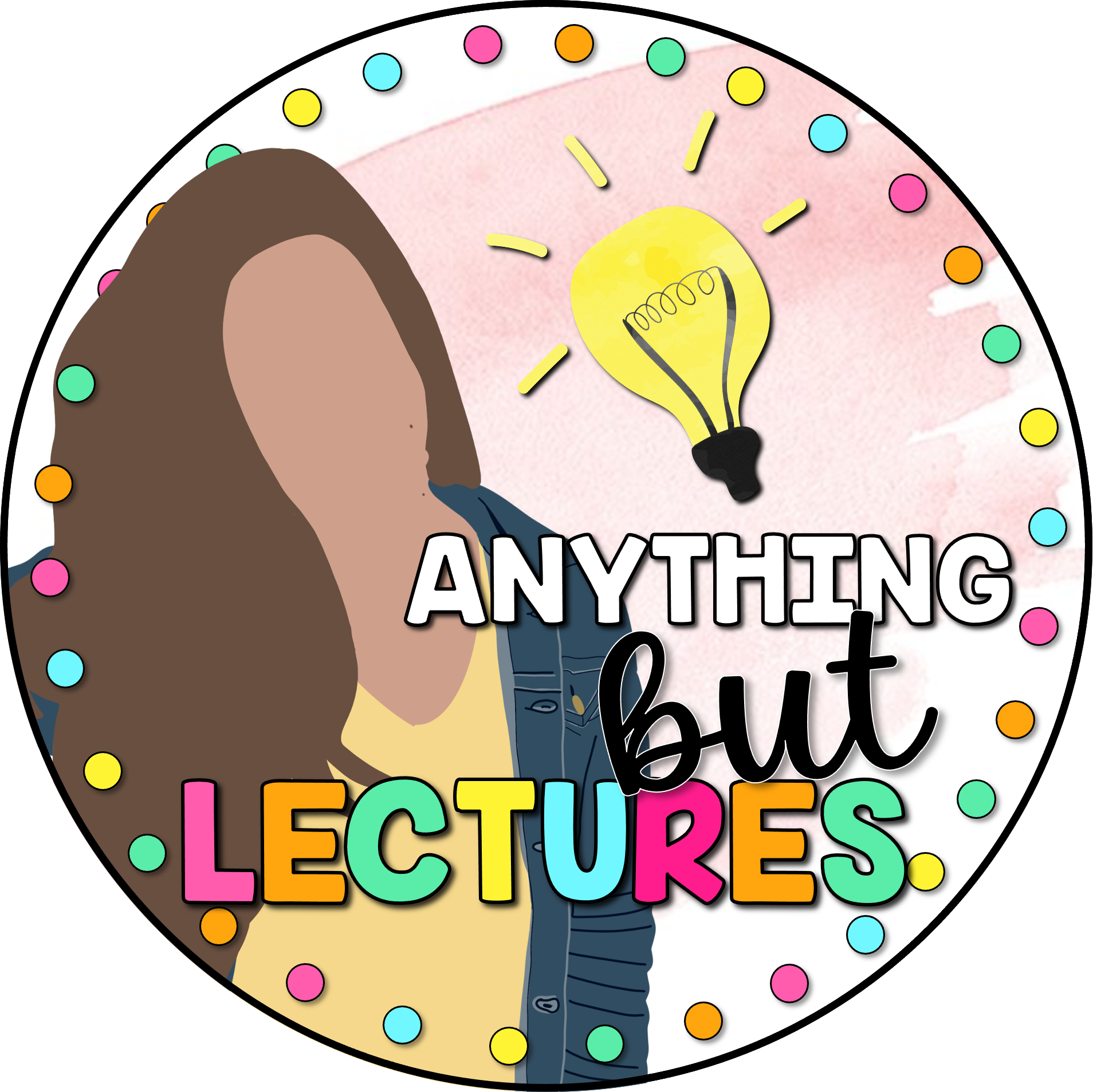What are the study habits you remember learning in elementary school? I don’t know about you, but I only remember learning how to study when I got to college. I didn’t know how to take notes effectively, how to study productively or how to manage my time when taking a test.
When was this taught to you?
I remember being a late teenager and thinking to myself, “Why didn’t I learn this sooner?”
If you already are teaching these skills to students, go you! But for the rest of us, I think it’s time to ask ourselves, “are we teaching our students how to learn?”
So what are the habits you could start with? Keep reading for 5 ideas on study habits to teach your elementary students…
Be sure to download the Free Soft Skills Guide for Elementary Teachers. Click here to get it now!
What are the Study Habits?
- Strategies for Taking Notes
- How to Review for a Test
- Pre-test Habits
- Test-Taking Strategies
- Managing Test Anxiety

Study Habit #1-Note-taking
Is it just me, or is note-taking a dying skill? A professor at Cornell University found that roughly 65 % of students in university take notes, yet students who take notes and review their notes regularly are 80 % more likely to remember what they have learned.
Note-taking may seem too difficult for elementary students to manage. How can we expect young students to take a blank sheet of paper and turn it into a neatly organized mecca of notes that can be reviewed?
That’s why starting small is the way to go. Here are some tips to get started with note-taking:
- Provide templates
- Model how to take notes
- Teach students about different note-taking methods
- Focus on just one subject/topic to take notes on to start
- Post examples around the classroom
Study Habit #2-Reviewing for a test
You may have noticed that in the last section I mentioned students were 80% more likely to remember what they learned if they take notes and review them. Review is an important part of the learning process. This especially includes when and how you review.
This is outlined in the Forgetting Curve (Ebbinghaus), which found that:
- At the end of the lesson you know 100% of the content taught to you
- By day 2, you will have lost 50%-80% of what you learned.
- By day 30, we retain about 2%-3% of the content taught during that original lesson!
So how do we avoid the curve? Luckily researchers came up with a formula:
- Within 24 hours of getting the information – spend 10 minutes reviewing and you will raise the curve almost to 100% again.
- A week later (day 7), take 5 minutes to “reactivate” the same material,
- By day 30, your brain will only need 2-4 minutes to give you the feedback, “yes, I know that…”
So not only is it important to write good notes, but to have time in class to review these notes. Be sure to download the soft skills guide that gives other ideas on how to teach soft skills by introducing small daily habits.
Click here to check out my review game for any subject!
Study Habit #3-Pre-test Habits
Elementary students are not too young to learn how to physically, mentally and emotionally prepare for an assessment. Some of these healthy habits include:
- Review a final time
- Eat enough healthy food before a test
- Get enough sleep leading up to an exam
- Drink tons of water
- Be on time
- Exercise
Study Habit #4-Taking a Test
Did you know there are strategies to taking a test? For example, when answering a multiple-choice test, best practices include skimming the test first, then answering the questions you know. Skimming helps because there may be clues to questions you don’t know found in other questions.
Teaching these strategies to students and practicing them by doing daily review questions and/or quizzes will help students learn and use these strategies.
Click here to download the free soft-skills guide for elementary teachers. This guide includes daily habits, tips and tricks for teaching students soft skills like study skills, empathy and more!
Study Habits #5-Managing Test Anxiety
Test anxiety is a real thing and can happen to college students, as well as young children. Here are some ways to teach students how to manage test anxiety…

- Talk about it. Ask what’s making them nervous. Review test formats and give sneak peeks if possible
- Prepare and review whenever possible
- Use students’ learning styles to their advantage- If students are visual, use flashcards. Make an obstacle course or scavenger hunt for kinesthetic learners. Click here to read my blog post on engaging student activities.
- Teach and review basic strategies that they will need for that subject
- Build confidence by giving positive reinforcement
- Support students and make sure they know how to use them. When possible, provide students with visual reminders such as sticky notes, bookmarks and posters that they can use during the test
Final Thoughts
To recap, here is a recap of the 5 study habits to teach your elementary students:
- Take notes
- Review
- Pre-test Healthy Habits
- Test-Taking strategies
- Managing test-taking anxiety
Do you have other study habits that should have been included? Comment down below!
Here are some other related blog posts:
What Are Hard Skills And Soft Skills- How Do They Show Up In Education?
The Top 3 Hurdles Facing Teachers Teaching Students Soft Skills
5 Creative Ways to Develop Empathy Skills In Your Classroom
PS Don’t forget to grab the free Soft Skills Guide for Elementary Teachers






4 thoughts on “What Are the Study Habits I Should Be Teaching My Elementary Students?”